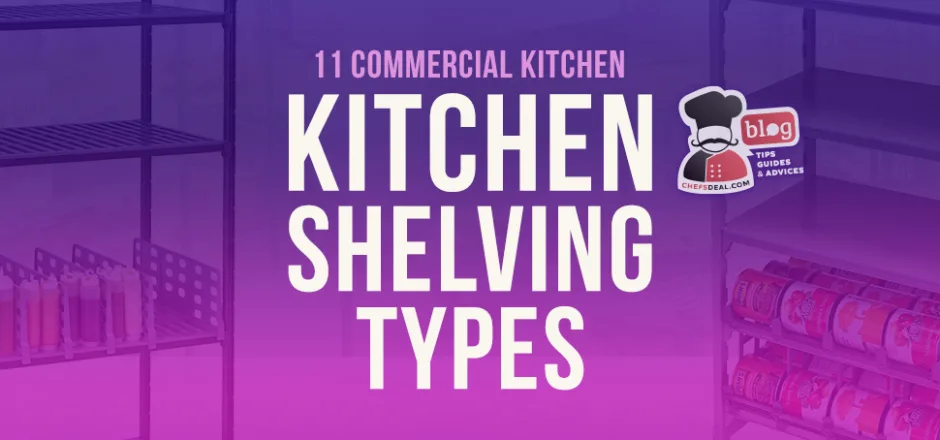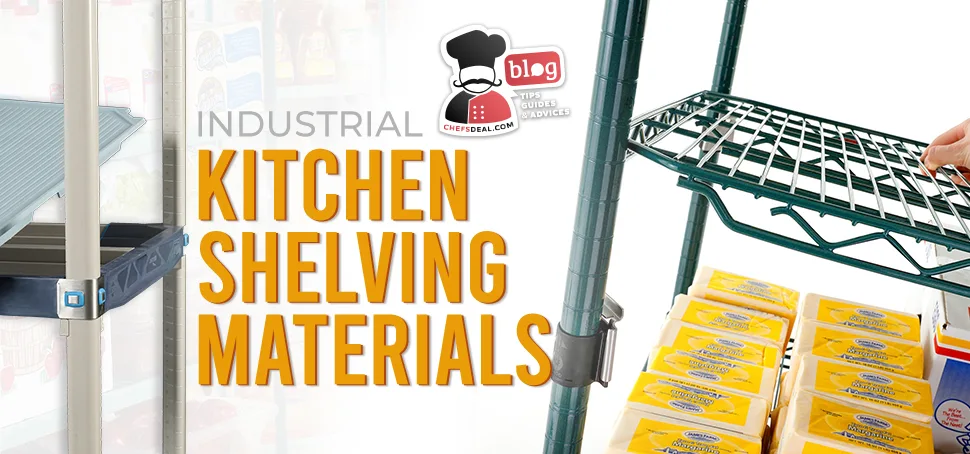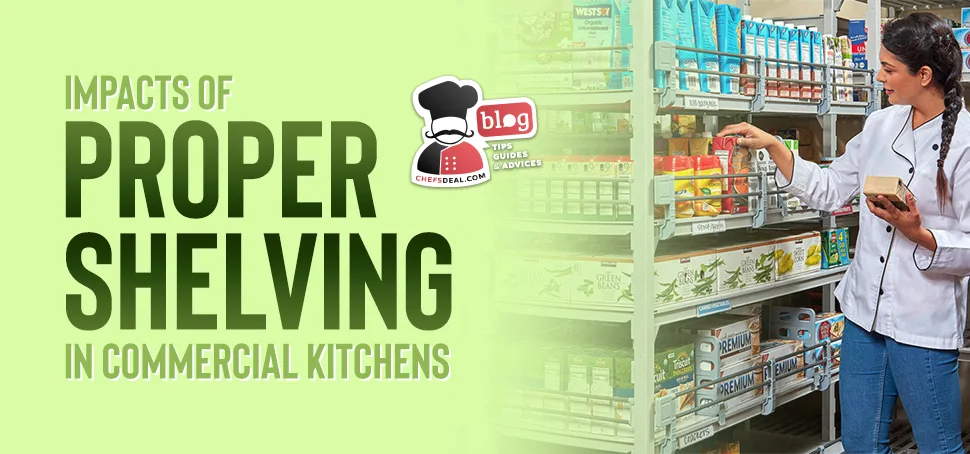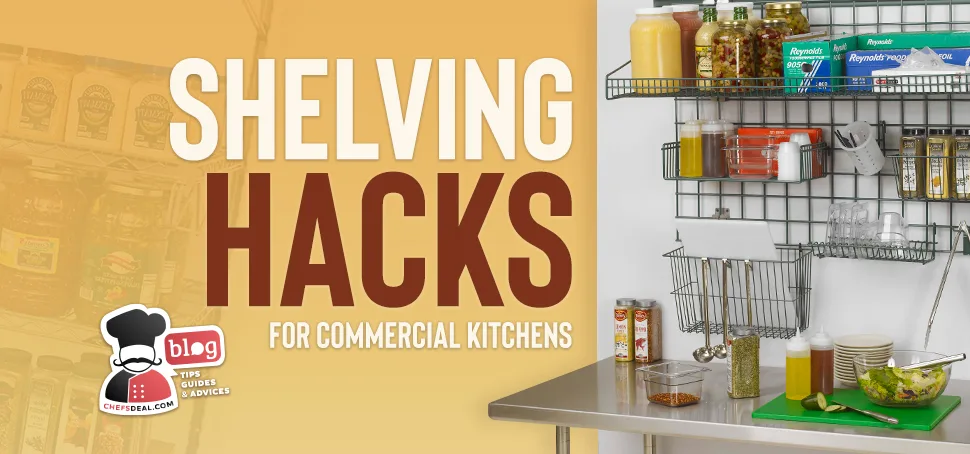Commercial kitchen shelving is the cornerstone of creating an organized backhouse and streamlined storage for food service businesses. This guide explores 11 different commercial kitchen shelving types below:
- Wire Shelving
- Solid Shelving
- Wall-Mounted Shelving
- Mobile Shelving
- Dunnage Shelving
- Overhead Shelving
- Corner Shelving
- Slanted Shelving
- Modular Shelving
- Cantilever Shelving
- Specialty Shelving
Each shelving type is designed to meet specific storage needs, from the lightweight and versatile wire shelving to the robust and spacious cantilever systems. Material choices like stainless steel, aluminum, and various coatings ensure durability and compliance with health standards, while design features like adjustability and mobility cater to dynamic kitchen environments. The selection of shelving significantly impacts the workflow, safety, and overall atmosphere of a commercial kitchen.
1. Wire Shelving
Commercial wire kitchen shelving is a lightweight storage unit consisting of steel wires. These easy-to-assemble units allow air ventilation through the wires, providing ideal storage for dry goods and equipment, saving valuable floor space, and increasing storage capacity.
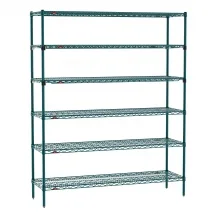
Industrial wire shelving racks have a weight capacity of up to 800 lbs (362.874 kg) per shelf, depending on the size, material, and construction. They do not support heavy equipment, but they are great for storing dry products and huge yet lightweight equipment. The open wires of wire shelving provide great visibility, allowing for easy access and quick retrieval of the stored products.
To choose the right size based on your space constraints, begin by measuring the space you want to install wire shelving and the products you want to store to determine the minimum height and depth of each shelf. Opting for wire shelving with casters provides the flexibility to place or move it wherever you want, depending on changing needs, which is especially efficient for small kitchens.
Material of Wire Shelving
Stainless steel is one of the most common wire shelving materials. Stainless steel with a minimum of 10.5-11% chromium and less than 1.2% carbon is rust-resistant and durable, minimizing the risk of corrosion and providing a longer lifespan than other wire shelving materials. Stainless steel is hygienic and non-toxic, and its easy-to-clean surface reduces the risk of cross-contamination, making it safe to use in commercial kitchens.
Wire kitchen shelving is made of alloy and carbon steel and coated with various coating to protect the steel against rust and corrosion. Chrome wire shelving is one of the most used coatings, giving alloy steel shelves a durable and corrosion-resistant finish. Chrome wire shelves are more visually appealing than galvanized wire shelves.
Galvanizing wire shelves means a steel wire coated with a protective zinc coating to prevent corrosion. Galvanized shelves are not as visually appealing as other materials but are less costly and provide great resistance to abrasion. Powder coatings are oven-cured thermoplastic dry powders that provide protection against oxidation. Powder coating can chip, crack, and peel, requiring regular inspection and maintenance. Powder coating provides a more durable finish than liquid painting.
Pros & Cons of Wire Shelving
- Wire shelving is a durable, easy-to-clean, and customizable commercial kitchen shelving type. With a wide range of sizes, designs, coating, and colors, you can find the best one for your needs. With finish options from nickel chrome plating to black epoxy and antibacterial coatings, you can perfect your kitchen design and storage needs.
- Due to its open shape, wire shelving is easy to clean, accumulating less dust and dirt than other shelves. The open form provides improved air circulation, reducing moisture buildup and keeping perishable goods fresh for longer. It provides fewer hiding places for pests, preventing contamination, which ensures food safety.
- Wire kitchen shelves may have poorer weight-bearing capacity and stability than solid shelves, making them unsuitable for heavy items. They are susceptible to bending and warping over time when not properly supported.
- Wire shelves are not suitable for small items because of the gaps between the wires, which can cause them to fall through or become unstable. They may seem less attractive than solid shelves for some, giving the kitchen an industrial look.
Popular Brands for Wire Shelving
Metro, Eagle Group, and Quantum are the most popular wire shelving manufacturers. These brands offer wire shelving in different materials and sizes.
2. Solid Shelving
Solid shelving is a type of shelving with shelves made from solid materials without any gaps or perforations. This type of shelving is often constructed from metals like stainless steel and aluminum or from materials such as wood or polymer, offering a continuous surface that’s ideal for storing small items that could fall through vented or wire shelves.
Solid shelves are preferred in environments where ease of cleaning is a priority, as their smooth, unbroken surfaces are typically easier to wipe down and sanitize. They’re commonly used in commercial kitchens, medical storage, and any setting where stability and cleanliness are essential.
Solid shelving is one of the most preferred, durable, and versatile commercial kitchen shelving types. They are suitable for storing small items that can fall through the openings of wire shelving. Both aluminum and stainless steel solid shelves give kitchens an industrial and modern look.
Stainless Steel Solid Shelving
Stainless steel solid shelving is highly durable and resistant to corrosion, rust, staining, and chipping. It is a versatile shelving type used in many industries and commercial kitchens. Stainless steel solid shelves can store large and heavy items as well as delicate items that can be damaged by wire grids. They are easy to clean and maintain.
The average weight capacity of commercial stainless steel solid shelves can range between 200 lbs (90.7184 kg) and 2000 lbs (907.184 kg) per shelf. Stainless steel solid shelves have diverse weight capacities depending on the size and construction of the unit, as well as the additional supports and reinforcements.
Pros and Cons of Stainless Steel Solid Shelving
- Stainless steel shelving is highly durable due to its high weight capacity and solid construction. It easily handles large and heavy items.
- Heat changes do not impact steel or weaken its tensile strength the way that temperature does for polymer shelvings.
- Stainless steel is a non-porous material, meaning it doesn’t harbor bacteria and germs, making it hygienic and safe to use in kitchens.
- Stainless steel solid shelving is quite easy to clean. You can just wipe the dirt and dust out with a cloth without worrying about damage or stains.
- Stainless steel solid shelving doesn’t scratch easily and has a longer lifespan than most other materials.
Aluminum Solid Shelving
Aluminum solid kitchen shelving is lighter than stainless steel and less resistant to corrosion. It can hold up to 900 pounds per shelf, changing depending on the shelf thickness, shape, size, construction, and reinforcements. Although it does not have the same weight capacity and strength as stainless steel, its light weight allows for easy carrying and moving inside the kitchen to meet changing needs.
Aluminum shelving is less costly and easier to clean. Aluminum kitchen shelving is best suited for storing dry goods. Aluminum solid shelving gives the kitchen an industrial and modern look.
Pros & Cons of Aluminum Solid Shelving
- Aluminum is a moisture-resistant material, making it ideal for kitchen use. The thin oxide layer on aluminum shelving makes it resistant to chemicals and cleaning agents, and the non-porous surface prevents bacteria and germ accumulation, ensuring food safety.
- Aluminum solid kitchen shelving requires little maintenance and is easy to clean, like stainless steel solid shelving.
- Dirt and dust can be removed with a damp cloth. Oxide and powder coatings can enhance the rust resistance of aluminum shelving, extending its lifespan.
- Aluminum is a soft and lightweight material that can bend when used to store heavy items exceeding its weight capacity. Depending on the thickness and construction of the shelves, this can be solved.
- Aluminum kitchen shelving can make a clanging noise that can be annoying for some. But with soft-close hinges, you can easily solve this problem.
Popular Brands for Solid Shelving
Regency, Cambro, and Metro Shelving are popular solid shelving brands.
3. Wall-Mounted Shelving
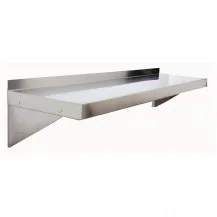
Wall-mounted kitchen shelving is shelving mounted on walls to save valuable floor space and provide extra storage. They are especially efficient for kitchens with limited floor footprints.
The average weight capacity of wall-mounted shelving changes between 45 lbs (20.411 kg) and 450 lbs (204.116kg), depending on the size and material. Wall-mounted shelving can be used to store constantly used items for easy access, such as glasses near the bar area or cooking tools near the cooking area, providing an organized environment.
Material of Wall-Mounted Shelving
Wall-mounted shelving is available in stainless steel, aluminum, wood, and wire, allowing you to choose the right one to fit your kitchen design. Stainless steel wall-mounted shelving is the most durable and has a high resistance to moisture. Solid wood shelves are a classic option with high durability, yet they have a lower resistance to moisture and require more maintenance. There is wire wall-mounted kitchen shelving that can be used for displaying purposes to enhance the aesthetics of your kitchen design.
Pros & Cons of Wall-Mounted Shelving
- Wall-mounted kitchen shelving is highly customizable and has a wide range of sizes, materials, and design options. You can find a wall-mounted shelf for all your different kitchen requirements, from displaying to storing heavy tools.
- Wall-mounted shelving offers both functionality and aesthetics combined. This versatile shelving is used for efficient storage or display of anything without sacrificing aesthetics.
- In addition to saving floor space, wall-mounted shelving creates a sense of airiness in the room, making it look wider and brighter.
- Wall-mounted shelving saves counter and floor space and makes efficient use of vertical space, providing an organized environment and effective storage space.
- Wall-mounted shelving can be unstable because it is supported only by wall brackets. So, it is not suitable for storing heavy objects.
- Wall-mounted shelving can accumulate more dust and debris from the air over time than other shelving and can be harder to clean because of their placement.
Popular Brands for Wall-Mounted Shelving
Eagle Group and Advance Tabco are well-known wall-mounted shelving brands.
4. Mobile Shelving
Mobile commercial kitchen shelving is moveable shelving units on casters. Mobile kitchen shelving allows you to move the unit easily with the built casters for changing storage needs and provides easy cleaning. They come in handy for small kitchens by pushing aside when unused, providing free space. Mobile shelving can be used to transfer heavy equipment and items within the kitchen.
The weight capacity of mobile kitchen shelving can vary depending on the material, construction, and size. The average weight capacity ranges between 40 lbs (18.1436 kg) and 400 lbs (181.436 kg).
Mobile kitchen shelving offers great flexibility and access. Since it is not fixed, it can be used wherever needed, providing easy access by keeping required items at hand.
Material of Mobile Shelving
Mobile shelving units are available in various materials, including stainless steel and heavy-duty plastic. Stainless steel is a more common option due to its high weight capacity, durability, and corrosion resistance.
Pros & Cons of Mobile Shelving
Mobile kitchen shelving provides extra storage space when needed and can be moved aside when not used, leaving free room in the kitchen.
Unlike fixed or heavy stable shelving units, they facilitate the cleaning process by rolling away and moving back when finished. They are especially efficient in areas requiring constant cleaning.
Mobile shelving can have the risk of injuries when moving, especially with heavy loads. Training staff on how to use it can eliminate safety hazards.
Popular Brands for Mobile Shelving
Eagle Group, Lakeside, and Metro Shelving are popular mobile shelving brands that offer versatile options for foodservice businesses.
5. Dunnage Shelving
Dunnage shelving is a heavy-duty shelving unit designed to store large, bulky items off the ground that can’t be stored in regular shelving, such as bags of flour, rice, canned goods, and heavy boxes. Dunnage shelving is used to prevent damage to the products due to dirt and water accumulating on the floor and provide stability to heavy items. They keep the items low to the ground and allow for airflow underneath the stored products. They are essential to comply with the health code, which requires food products to be kept at least 6 inches (15.24 cm) above the ground. There are ones with casters, providing mobility to move heavy items.
Dunnage shelving has a wide weight capacity, ranging from 500 lbs (226.796 kg) to 3000 lbs (1360.777 kg), ensuring safe storage of the heaviest loads. They are mostly used in pantries and cold storage, occupying very little space.
Material of Dunnage Shelving
Dunnage shelvings are typically made of materials like aluminum, polyethylene, polymer, and steel, which are all resistant to moisture and corrosion and have high weight capacities.
Pros & Cons of Dunnage Shelving
- The raised design of dunnage racks allows for easy cleaning beneath the rack without moving. It enhances ventilation underneath the product and reduces spoilage.
- Due to their low-to-the-ground design, durable dunnage racks can support a great number of weights. This provides storage for heavy and large items that can not fit on standard shelves.
- Aluminum and polymer dunnage racks are commonly preferred due to their high resistance to corrosion and changing temperatures, making them ideal for both cold and room-temperature storage.
Popular Brands for Dunnage Shelving
Rapids Wholesale, Eagle Group, Metro, and Regency are the popular dunnage shelving brands.
6. Overhead Shelving
Commercial kitchen overhead shelvings are ceiling-mounted storage spaces placed over workstations or islands in the kitchen. Overhead shelvings provide extra storage without taking up floor or wall space, making use of unused space. They free up countertops, leaving more room for efficient working and maximizing storage and kitchen space. They are used to store constantly used items such as spices, utensils, tools, and glasses within easy reach.
The weight capacity of overhead shelves ranges between 80 lbs (36.287 kg) and 150 lbs (68.038 kg). They hang at a height that won’t interfere with equipment and provides easy access.
Overhead kitchen shelves keep the kitchen organized and clean by freeing up counter space and making the kitchen look wider. This makes the kitchen visually appealing and improves its aesthetics.
Material of Overhead Shelving
Overhead kitchen shelving is made of steel frames and wood shelves or fully constructed from stainless steel for the highest durability and safe storage.
Pros & Cons of Overhead Shelving
- Overhead kitchen shelving enhances organization and maximizes storage space in commercial kitchens without taking up valuable counter and floor space, improving overall workflow.
- Overhead shelves provide storage spaces for necessary tools and items in different work areas in the kitchen, such as pots and pans in the cooking area or glasses in the bar area. This enhances accessibility and reduces time spent looking for items.
- Overhead kitchen shelving minimizes the need for excessive reaching, bending, and constant moving, reducing strain on staff and promoting an ergonomic working environment.
- Overhead kitchen shelves have limited weight capacity due to the structural integrity of the ceiling. Overloading the shelves or ignoring the restrictions may cause serious safety risks.
- Overhead kitchen shelving may be more difficult to install than regular shelves and may require professional help, which can increase expenditures.
Popular Brands for Overhead Shelving
Advance Tabco, Eagle Group, and John Boos are the popular overhead shelving brands.
7. Corner Shelving
Commercial kitchen corner shelving is designed specifically to fit into corners and maximize storage space. These units provide efficient storage by utilizing underused or ignored corner spaces in kitchens. By using every inch of the kitchen, corner shelving transforms a cluttered space into an organized work environment.
The weight capacity of kitchen corner shelving depends on its design and material. The weight capacity of pull-out shelves in corner shelving typically changes between 50 lbs (22.679 kg) and 200 lbs (68.038 kg).
Corner shelving enhances accessibility with pull-out or swivel shelves to the hard-to-reach corner spaces. These features facilitate access to the items and reduce staff strain by eliminating bending or stretching.
Material of Corner Shelving
Corner shelving is made of stainless steel, aluminum, or epoxy-coated wire shelves, which are all corrosion—and moisture-resistant.
Pros & Cons of Corner Shelving
- Commercial corner shelving enhances storage capacity and kitchen organization by making use of unutilized corners in a kitchen.
- Commercial corner shelving and standard corner shelf units can be customized to fit the exact dimensions of each corner in different kitchens.
- Made of stainless steel and epoxy-coated wire, corner shelving is corrosion-resistant and easy to clean, providing safe storage.
- Commercial corner shelving doesn’t have high-weight capacities, so it’s not suitable for heavy items. Some corner shelves may not be installed at awkward-shaped corners, requiring customization.
Popular Brands for Corner Shelving
Regency Space Solutions offers corner shelving options as a popular shelving brand.
8. Slanted Shelving
Slanted commercial kitchen shelving is a shelving unit type in which the shelves are slanted at an angle instead of being flat. Slanted shelving is used to store canned goods to roll over when one is taken or with racks to store tableware for draining and drying before putting it in and after taking it out of the dishwasher. The slanted design of the shelves allows items to slide down, enhancing product visibility and accessibility and making racks easy to reach, facilitating the loading and unloading process. Slanted shelving is available in wall-mounted shelving or standalone units.
The average weight capacity of slanted shelves ranges between 200 lbs (90.718 kg) and 400 lbs (181.436 kg) per shelf. The weight capacity of these shelves varies depending on the unit type, such as a wall-mounted or standalone unit, and the material of the shelf. They are designed to enhance accessibility to stored items without the need for organizing them every time. You can opt for either a wall-mounted or standalone slanted shelf unit, considering your available space.
Material of Slanted Shelving
Slanted kitchen shelving is available in materials like stainless steel, chrome-plated steel, or steel wires.
Pros & Cons of Slanted Shelving
- Slanted kitchen shelves improve accessibility to stored items. The slanted design enables easy reach to stored goods, keeping the shelf organized because the items move forward without effort. This saves valuable time for staff and enhances workflow.
- They display stored items, enhancing visibility and making it easier for staff to find items quickly.
- Slanted shelves are unsuitable for storing every item and tool, making them less adaptable. Heavy and large objects may not fit well on slanted shelves, restricting their usage area.
Popular Brands for Slanted Shelving
Metro and Regency Space Solutions are the high-quality brands that are chosen by customers.
9. Modular Shelving
Modular kitchen shelving refers to moveable and adjustable racks and shelves and a selection of different types of units that together create fully functional and practical kitchen storage. The adjustable shelving allows one to tailor the kitchen storage to changing needs and preferences to maximize storage and functionality and optimize accessibility for the ideal working environment. They come in a variety of designs, materials, and sizes to fit all kitchen layouts and sizes.
The weight capacity of modular kitchen shelving changes depending on the shelving type, material, size, and construction. Depending on the intended use, customizing the shelf material and size will ensure safe storage without exceeding the available weight capacity.
The adjustability of modular kitchen shelves is designed considering the kitchen layout to achieve maximum accessibility. Creating a specialty shelving system brings items within easy reach with convenient storage solutions, streamlining the cooking process.
Modular shelving aims to maximize the kitchen’s layout for efficient storage. It offers the most efficient possible storage space, considering space constraints, storage requirements, and the overall kitchen layout.
Modular shelving enhances kitchen aesthetics in addition to providing functional benefits. By choosing options that complement your kitchen design from the wide range of available styles and finishes, you can improve the appearance of your kitchen while maximizing storage.
Material of Modular Shelving
Modular shelving in commercial kitchens is commonly made from chrome-plated steel, epoxy-coated steel, aluminum, polymer, and sometimes stainless steel. Material selection is based on the kitchen’s needs. Each material offers distinct advantages such as durability, resistance to corrosion, ease of cleaning, and the flexibility to reconfigure shelf layouts as storage needs evolve. Polymer and epoxy-coated models are especially popular for their rust-resistant properties, making them suitable for moist environments, while aluminum and stainless steel offer sturdy support for heavier loads.
Pros & Cons of Modular Shelving
- Modular kitchen shelving allows you to make the best use of the kitchen’s existing space. It enhances storage, provides an organized environment, and maximizes existing workspace with optimum space utilization.
- Modular shelving can be customized to fit the precise dimensions of your kitchen, leaving no space wasted, and all items and products are organized.
- Modular shelves ensure organization in the kitchen with different solutions for effective storage of every item. Combining different types of racks, shelves, and additional accessories creates a decluttered area and boosts organization for easy access and streamlined workflow.
- Modular kitchen shelving requires professional help for installation, adding to the costs, which can be a problem for pre-planned budget concerns.
Popular Brands for Modular Shelving
Cambro and Eagle Group are popular modular shelving.
10. Cantilever Shelving
Cantilever shelving is a kitchen shelving type without front posts that is supported by a rear anchor instead of mounting into the wall. The rear support system, called upright, eliminates the need for front support posts.
This design allows for more storage capacity, storage space for long and bulky items, and easier access to the stored products. With no front posts, cantilever shelving provides 30-50% more storage capacity than traditional shelving units in the same footprint, making it a more efficient kitchen storage option. It creates overhead storage without drilling the walls and enables storage for huge and irregularly shaped items. Most cantilever shelving features integrated notches that allow for adjusting the shelves without a need for any tools.
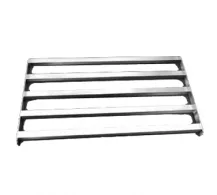
Cantilever shelving is designed to hold heavy and huge items, so it usually has a high weight capacity. The weight capacity of cantilever shelving varies depending on the shelving type, such as solid shelves or wire, material, and size. The average weight capacity of steel solid cantilever shelving ranges between 700 lbs (317.514 kg) and 900 lbs (453.592 kg) per shelf.
The elimination of front posts in cantilever shelving allows for unobstructed access to the stored items, making it easier to retrieve and organize them. They use overhead space, saving floor space, which is highly valuable for small kitchens.
Material of Cantilever Shelving
Cantilever shelving is mostly made of durable materials such as stainless steel and epoxy-coated wire, which ensures its durability and endurance under heavy usage.
Pros & Cons of Cantilever Shelving
- The open fronts of cantilever shelving provide more usable storage space, making it effective for kitchens with limited space. Cantilever shelving enhances usable surface area more than shelving with front posts.
- The design of cantilever shelving without the front posts increases accessibility and angle of operation while reducing possible injuries and enhancing employee safety.
- The design of cantilever shelving facilitates the cleaning process of both the shelves and the floor space.
- Due to high gauge and durable construction, cantilever kitchen shelving costs more than other shelving types.
Popular Brands for Cantilever Shelving
Eagle Group, Metro, Winholt, and Quantum are highly preferred cantilever shelving manufacturers.
11. Specialty Shelving
Specialty kitchen shelving is a shelving type that accommodates the specific storage needs of a commercial kitchen. Pot and pan racks hold pots and pans, while condiment racks are designed to organize spices, sauces, and kitchen utensils. Dish racks hold tableware and glassware for washing, wine racks provide proper storage space for wine bottles, and boat racks are designed to store boat trays.
Pot and Pan Racks
Pot and pan racks are designed specifically to hold and organize pots, pans, and cooking utensils. They are commonly mounted or ceiling-mounted near the cooking area, and pots and pans are hung from the handles. This saves great cabinet space and allows for easy access to constantly used cooking tools. Pot and pan racks come in various styles, such as grid and shelf style, and feature hooks for hanging pots and pans.
The weight capacity of pot and pan racks changes depending on the type, design, size, and material of the rack. The average weight capacity of the commercial pot and pan racks ranges between 50 lbs (22.679 kg) to 200 lbs (90.718 kg). Installing the pot rack at a proper height ensures easy reach and accessibility, avoiding stretching and bending to reduce staff strain and streamline workflow.
Material of Pot and Pan Racks
They can be made of durable materials like stainless steel, aluminum, and heavy-duty plastics or composites. Stainless steel is favored for its robustness and resistance to corrosion, making it ideal for heavy pots and pans. Aluminum is chosen for its lighter weight, good strength-to-weight ratio, and corrosion resistance. Heavy-duty plastics are less common but can be used in environments where lighter pans are stored, offering the benefits of not rusting and being easy to clean.
Popular Brands for Pot and Pan Racks
Omcan and John Boos are pot and pan racks manufacturers who are highly preferred by the foodservice business.
Condiment Racks
Condiment racks are shelving units designed to organize condiments, spices, and sauces. Placing condiment racks near the cooking area enhances accessibility, and the organized storage of the spices provides visibility and easy recognition.
Condiment racks come with built-in separators or organizers to keep various spices separate and easily accessible. Organizing spices at hand facilitates the chef’s work in finding what they are looking for, reduces clutter, and simplifies the cooking process.
Material of Condiment Racks
Condiment racks are made of plastic or stainless steel for durability and easy maintenance.
Popular Brands for Condiment Racks
FMP and TableCraft Products are popular condiment rack brands.
Dish Racks
A dish rack is a shelving type designed to store dishes, glassware, and flatware during the washing cycle inside the dishwasher or to dry tableware after washing at hand. They are designed specifically for dishwasher size to prevent chipping and breakage of the glassware and dishes during the washing process. They ensure proper washing.
Dish racks are available in different sizes and types and are designed specifically for different types of glassware and dishes, such as wine glass racks or glass racks designed to hold beer mugs.
The dish drying rack is a dish rack type that is designed with a functional design that holds the dishes at a certain angle and dries dishes faster by ensuring extra water is poured away. With extra attachments, drying racks or dish racks can be turned into storage boxes to carry the dishes inside the kitchen.
Material of Dish Racks
Dish racks are made of polypropylene, coated wire, stainless steel, plastic, and nylon-coated for optimizing space and durability.
Popular Brands for Dish Racks
Electrolux, Eurodib USA, and FMP are the popular dish racks brands.
Commercial Wine Racks
Commercial wine racks are shelving types specifically designed to hold wine bottles. Wine racks hold wine bottles at a proper angle that protects the wine’s quality while allowing air to circulate through to maintain a proper and stable temperature, keeping the wine ready for consumption. The inclined design of wine racks allows the cork to stay fully moist, which is how wine must be stored.
There are wooden and metal wine racks. Wood wine racks give the kitchen environment a classic, rustic look, while metal racks are a sleeker, modern, and durable option. Wine racks’ weight capacities depend on their material, size, and the number of bottles they can hold. For instance, a chrome wire wine rack with a 9-bottle capacity can hold up to 100 lbs (45.359 kg) per shelf.
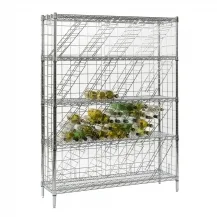
Material for Wine Racks
Commercial wine racks are made of wood, metal, or plastic.
Popular Brands for Wine Racks
Eagle Group and Tarrison are two important wine rack manufacturers.
Boat Racks
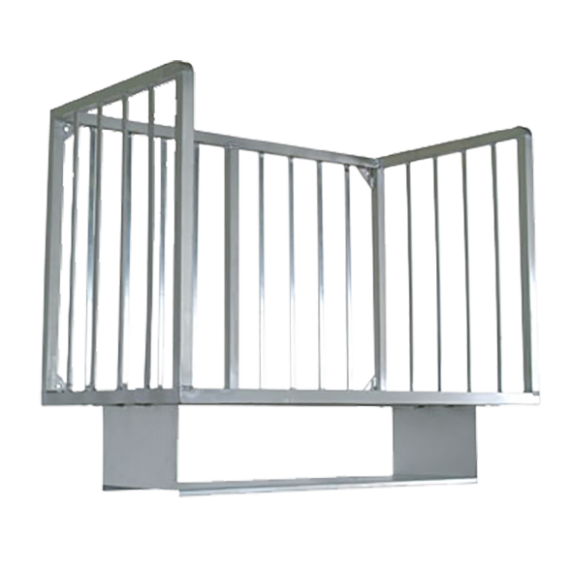
Boat racks hold and transport sheet pans, boat trays, and food prep supplies in commercial kitchens, bakeries, or butcher shops. They typically consist of a frame with multiple shelves where boat trays can be placed for efficient storage and easy access near prep areas.
Material of Boat Racks
Boat racks are mostly made of aluminum because of their lightweight or stainless steel for extra durability. They consist of tubular frameworks and mesh backs and bases to hold the stocks safely.
Popular Brands for Boat Racks
New Age and John Boos are the popular boat rack manufacturers.
Commercial Kitchen Shelving Ideas: Functionality and Aesthetic
Commercial kitchen shelving must be both functional and aesthetically pleasing to achieve harmony for optimized efficiency and a visually appealing workspace. Functionality prioritizes ease of use, safety, adjustability, and accessibility while ensuring compliance with regulations. The aesthetics of kitchen shelving aim to integrate the shelving with the overall kitchen design and environment by complementing the kitchen’s theme, material choice, and style. Finding a balance between functionality and aesthetics at shelving is important to creating the ideal storage solution.
Functionality
Functionality in commercial kitchen shelving refers to its ability to effectively store, organize, and access ingredients, equipment, and supplies. Functionality in kitchen shelving prioritizes creating a workflow that maximizes efficiency and safety in a busy kitchen environment. Each type of commercial kitchen shelving can come with different functional features. For instance, wire shelving enhances air circulation through its openings, preventing mold growth and making it ideal for storing dry goods. On the other hand, Cantilever shelvings provide easy access and functional storage for bulky items and equipment because there are no front posts.
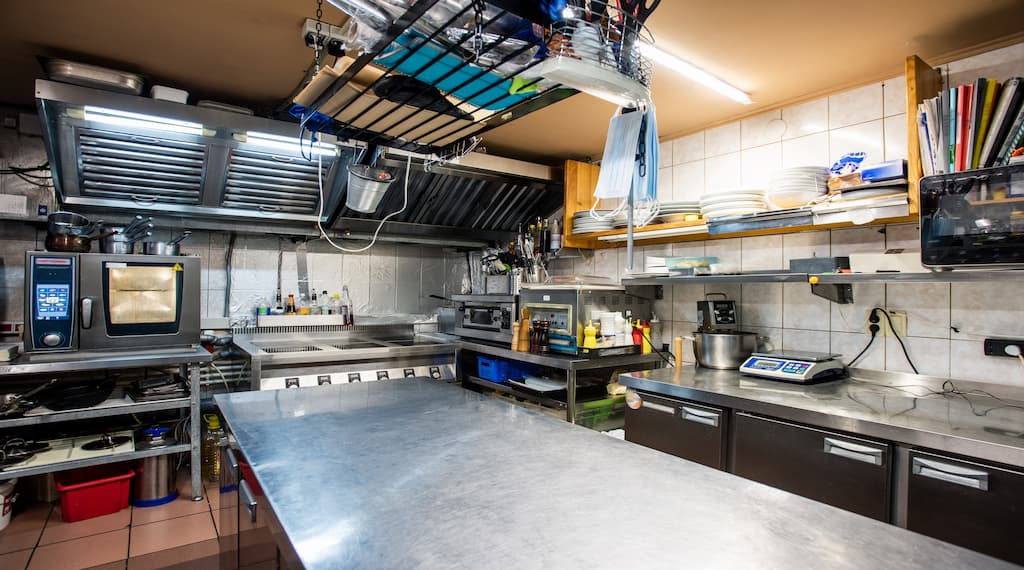
Factors to Consider for Functional Shelving
Functionality is one of the key commercial kitchen shelving factors that directly impact the efficiency and safety of daily operations. The factors below are what ensure the functionality of shelving:
Weight Capacity: Commercial kitchen shelving must be able to support the weight of various kitchen items, from lightweight utensils to heavy commercial kitchen appliances. Knowing the weight limits of each shelf and avoiding overloading eliminates the risks of structural failure and possible injury.
Accessibility: Commercial kitchen shelving should be arranged to allow easy access to frequently used items. A properly planned shelving system and layout reduce the time and effort needed to locate and reach for essential ingredients and equipment and improve movement inside the kitchen, facilitating a smoother workflow.
Material Suitability: The choice of material for kitchen shelving should consider the environment in which it will be used and the intended use of storage. Heat-resistant materials are essential in high-temperature areas, whereas materials that allow for easy cleaning and maintenance—like stainless steel—are preferred in areas prone to spills or mess. For heavy and bulk tools and equipment, more durable and solid materials are preferred to ensure safety.
Adjustability: Adjustable kitchen shelving offers the flexibility to accommodate different sizes of equipment and supplies and the changing kitchen needs. This feature is particularly important in commercial kitchens where the menu offerings can change seasonally, necessitating different storage configurations.
Code Compliance: Commercial kitchen shelving must comply with local health and safety codes, which may include requirements for materials, construction, placement, and maintenance. Complying with these codes ensures the safety of staff and customers, facilitates clean and hygienic food preparation areas, and helps avoid potential legal issues or fines.
Aesthetics
Aesthetics in commercial kitchen shelving refers to the visual appeal and overall impression the commercial kitchen shelving creates within the kitchen with the design, material, and style. It goes beyond simple functionality and considers how the shelving integrates with the design and atmosphere of the kitchen. The shelving material can evoke different feels, from modern and clean to rustic and comfortable. The style and type of kitchen shelving can change the aesthetic to a minimalistic or industrial look. For instance, open shelving provides an airy and open look, while closed cabinet shelvings provide a more organized environment.
Factors to Consider for Aesthetically Shelving
Aesthetics contribute to the overall atmosphere and can enhance both employee satisfaction and customer perception. When selecting aesthetically pleasing shelving, you can consider the following factors:
Overall Kitchen Design: Commercial shelving should complement the kitchen’s overall design scheme. Whether the kitchen has a rustic charm or a sleek contemporary look, the shelving should integrate seamlessly to achieve harmony, contributing positively to the ambiance.
Finish: The finish of the kitchen shelving greatly affects its appearance and maintenance requirements. Options include polished, brushed, matte, or even coated finishes, each with a different aesthetic and level of ease of cleaning. The finish or paint of the kitchen shelving has a huge impact on complementing the overall aesthetic of the kitchen.
Style: Restaurant shelving should reflect the kitchen’s theme. Modern kitchens may opt for minimalist designs with clean lines, while industrial-themed spaces might choose robust, exposed shelving systems emphasizing functionality and raw materials.
Material: The choice of material can define the shelving’s look and feel. Stainless steel offers a clean and professional appearance, while wood can bring warmth and natural texture to the space. Each material carries implications for durability and upkeep, which should align with the kitchen’s operational demands.
Balancing Functionality and Aesthetics
Striking a balance between functionality and aesthetics of commercial kitchen shelving brings the best storage solutions, enhances staff performance, and streamlines operations. Balancing functionality and aesthetics when choosing commercial kitchen shelving can be done by considering the kitchen’s needs and design aspirations.
It’s about choosing shelving that can withstand the kitchen’s hustle and bustle while fitting into the desired visual narrative. For instance, stainless steel shelves, while highly durable and easy to clean, can lend a contemporary look. Wood, on the other hand, adds warmth but requires more maintenance and may not be suitable for all storage needs.
For a kitchen to be truly efficient and inviting, its shelving must meet the practical demands of chefs and the aesthetic expectations of patrons. In practical terms, this means selecting shelving with the right dimensions to utilize the available space effectively without hindering the movement of kitchen personnel.
The choice of material is equally essential; for instance, high-grade stainless steel offers resistance to corrosion and ease of cleaning while ensuring the kitchen exudes a professional look. At the same time, incorporating wooden accents through shelving can introduce a touch of organic warmth, making the space more welcoming.
It’s often advisable to seek professional design consultation to ensure that the chosen shelving solutions align with both these crucial aspects. Professional advice can be invaluable by offering insights into the latest materials and designs that meet industry standards for health and safety while aligning with contemporary trends. Expert consultants can help navigate the complexities of certification requirements, ensuring all shelving is up to par with regulatory demands.
A harmonious blend of utility and beauty in shelving can transform a commercial kitchen into a powerhouse of efficiency and a bastion of style. As such, it’s worthwhile to invest time and resources into selecting the perfect shelving solutions that will optimize operational efficiency and enhance the aesthetic appeal of the culinary space.
Conclusion to Commercial Kitchen Shelving Types
Equipping your commercial kitchen with the right shelving solution is crucial for organization, space optimization, and workflow efficiency. Each commercial kitchen shelving type has its own advantages and disadvantages. From the all-around functionality of wire shelving to the area-saving benefits of corner units, selecting the most suitable option depends on your specific needs and kitchen layout.
While this guide provides a comprehensive overview of the most common shelving options, it is highly recommended that you consult with a professional storage solutions provider. An expert can assess your kitchen’s space constraints, weight capacity requirements, and aesthetic preferences to design a customized shelving plan. They can help you determine the optimal combination of shelving types, such as wire shelving for dry goods paired with pot racks for easy access to cookware. Remember, it’s often a combination of different shelving types that creates the most functional and aesthetically pleasing storage solution for your commercial kitchen, ensuring a streamlined workflow and a well-organized environment for your staff.

